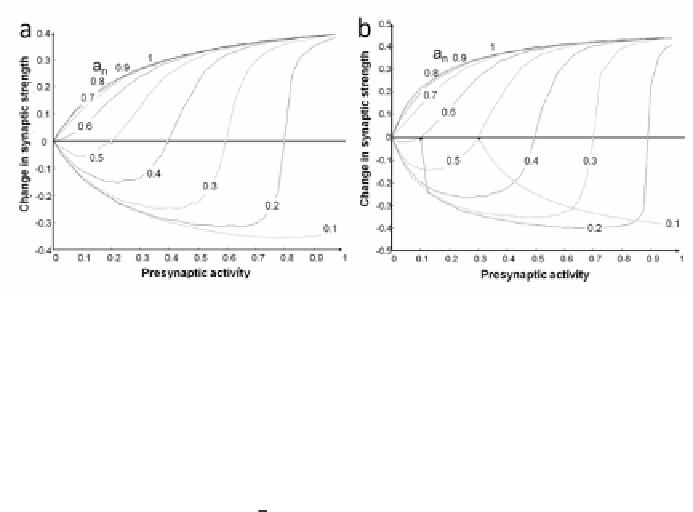Information Technology Reference
In-Depth Information
Fig. 5.
Synaptic weight variation in terms of presynaptic activity (with the activation
of neighbouring synapses an as a parameter). Presynaptic probabilistic equation with
the ABS rule (a) Using a probabilistic presynaptic equation with a non-linear activation
function (sigmoid).(b) Taken property A.3 into account.
To test whether the conditional probability model of synaptic plasticity is
consistent with the ABS rule, the presynaptic probability
I
is represented in the
horizontal axis. To obtain
P
(
i
),
o
is given by
o
=
f
∗
(
a
), a being a function of
both
I
and
a
n
, according to equation 10. Fig. 5.a seems to encompass more
consistently the ABS rule (Fig. 2.b) than our previous attempt in Fig. 3.c. If
property A.3 is taken into account (so that a is obtained from Eq. 13 Fig. 5.a
become Fig. 5.b, which is even more consistent with the ABS rule (compare with
Fig. 2.b).
4Con lu on
In this work, we have analyzed the presynaptic rule of synaptic plasticity in the
light of recent biological findings such as synaptic directionality, metaplasticity
of potentiation and depression thresholds, and the influence of nearby synapses
(the so called “ABS” rule) over the synapse under study.
The presynaptic rule is consistent with synaptic directionality and LTP meta-
plasticity, in the case of homosynaptic plasticity, and with LTD metaplasticity
and the ABS rule, in the case of heterosynaptic plasticity.
All these properties were studied with: a) the incremental equation of the
presynaptic rule, assuming linearity of the activation function around the av-
erage activation set-point, and with b) the probabilistic version of presynaptic
rule in which a logistic activation function was utilized. While both analyses
were consistent with biological findings, the latter seemed to more accurately
encompass the qualitative features of experimental curves.





Search WWH ::

Custom Search